Spotlight Articles And Features
Night Crossing Album Diary
Karl Scott, co-producer
of the original Intrada release of Night Crossing, reminisces and shares his rare
collection of photos he took during the production of the incredible Night Crossing album.
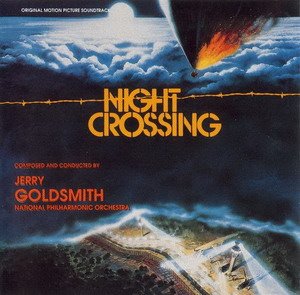 I was born in December of 1946 and became a film
music fan (probably just like you) at an early age. Henry Mancini was an early
favorite, one of the reasons being the readily availability of HM's music on LP
and 45's. I first heard a score by JG when I went to the Esquire Theater in
Stockton, California to see the film "Lonely Are the Brave". This score
has been recently released for the first time (thank you Varese Sarabande) on
CD. In the early '60's if you wanted to hear this score you had only one choice.
Go sit in the theater and listen. When JG's first score (4 tracks from The
Prize) made it to LP I was a devoted fan. I purchased every LP by JG ever
released. Thanks to Night Crossing I now have a copy of The Prize
on my wall signed by Jerry. As the '60's and '70's passed by I was devoted to
Jerry and his music which touched a nerve within me. When I reached a point
where I was going to co-produce one of his scores it was one of the highlights
of my life. It was the summer of 1987 and hot in L.A. I was born in December of 1946 and became a film
music fan (probably just like you) at an early age. Henry Mancini was an early
favorite, one of the reasons being the readily availability of HM's music on LP
and 45's. I first heard a score by JG when I went to the Esquire Theater in
Stockton, California to see the film "Lonely Are the Brave". This score
has been recently released for the first time (thank you Varese Sarabande) on
CD. In the early '60's if you wanted to hear this score you had only one choice.
Go sit in the theater and listen. When JG's first score (4 tracks from The
Prize) made it to LP I was a devoted fan. I purchased every LP by JG ever
released. Thanks to Night Crossing I now have a copy of The Prize
on my wall signed by Jerry. As the '60's and '70's passed by I was devoted to
Jerry and his music which touched a nerve within me. When I reached a point
where I was going to co-produce one of his scores it was one of the highlights
of my life. It was the summer of 1987 and hot in L.A.
Disney maintains the long term rights to the score. In reproducing the music for album, rights to the music and the score itself has to be paid for and
obtained from the Studio. The up front fees collected by the Studios are the
fees for re-use of the music for a purpose other than music to accompany the
film. As I recall we paid approximately $15,000 so Disney would be assured of
covering the costs of the Union Musicians who have to be repaid for their work.
Since the music was recorded in England the re-use fees were much smaller than
if done in the USofA. If the score had been recorded here the re-use fees would
have been closer to $70,000 and along with production fees the album would not
have been released. This is why Goldsmith, Williams and major composers recorded
their scores with overseas orchestras knowing that this meant their work might
make it to LP, Cassette, or CD.
Disney Studios were unfamiliar with Intrada and refused to release the original
masters. Jerry who had not worked for Disney for years had no influence to
obtain the originals and claimed he no longer knew anyone there who had any
influence to trust him or us with the original master
tapes. This is one of the reasons that when Intrada re-released an extended
Night Crossing CD several years later the sound quality improved as by then then
they allowed use of the original master tapes. Also at that time (1987) there
were problems in how much music could be used without paying more and more money
in re-use fees to the Musicians Union. More on this including a great incident
with Jerry and Sidney Sax (Manager of the National Philharmonic Orchestra). Re-use
fees have always been a big problem in getting soundtracks released in any
quantity. That's why even today you see so many limited releases. The less
income projected the less you now have to pay for the re-use of the music. While
this situation has improved, it didn't help us at the time we were trying to
release Night Crossing in a full version. Disney maintains a vault in the
Midwest where original negatives and scores are kept in safe areas from
earthquake and other possible natural disasters. They flew out the originals and
made us a 1 to 1 copy of the original session masters. This is what we had to
use for the dubbing sessions and had some problems with the Dolby encoding. More
on this later. While at the Studios Doug and I had the good fortune to tour the
sets for the movie Big Business which was being filmed at the time. After
obtaining the rights and tape copy we went on to Len Engels home in Bel Air.
Len
Engel's residence and Contempo Recording
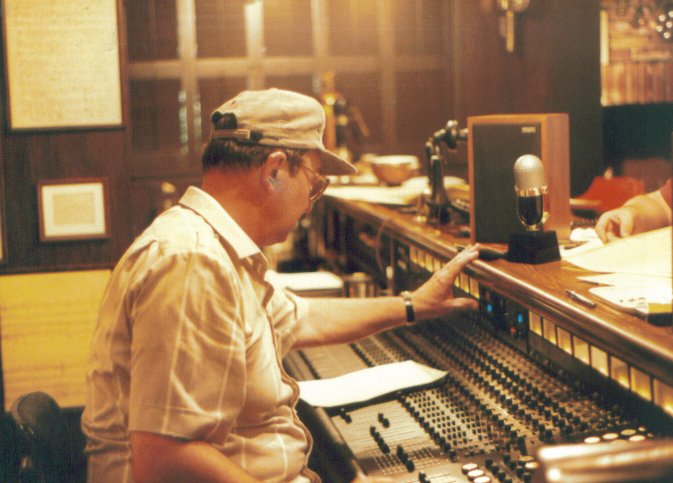
The late Len Engel was a long time film music
fan, music editor and mastering genius. He worked for many years at 20th Century
Fox and his name appears on many TV shows and movies. he worked with Jerry on
many albums and scores. Len created his mastering studio and Contempo Recording
Company out of the large living room of his Bel Air, CA home. As you review the
pix you will see his living room and its contents. Not seen are his garage where
he had Rachmaninoff's actual practice piano. Also he had a lot of tapes from the
20th Century Fox archives which he brought home and worked with. Len was the
reason I bought my first CD player. He had taken home the original master tapes
for The Blue Max and began mastering them for CD release. As I recall
this was the first JG score released on CD and I had no reason
to buy a player until this score was on CD. The remarkable story about how Len
found these tapes and their mastering and release on Varese Sarabande is told in
his excellent notes which accompany the CD.
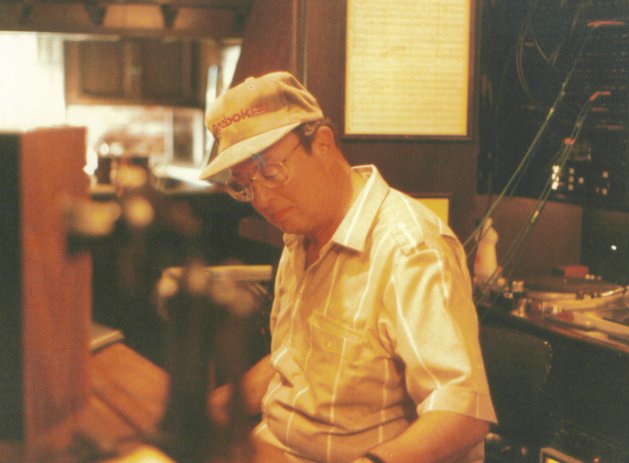
At one end there are a pair of massive speakers and at the other end the
mastering center. It is cleverly disguised as a bar. When behind the bar Len can
mix a drink or an album with equal ease. Behind the bar a roll up panel exposes
the mastering unit where he takes 16 track tapes and mixes the sound down to a
stereo master. Behind him are more panels which open up to expose the cassette
and reel-to-reel 16 track tape players. The panels contain sheet music all with
autographs by composers he has worked with over the years. As I recall he had an
original sheet by Jerry, John Williams and Bernard Herrmann and Henry Mancini
all signed and given to him with their thanks. There is another room behind the
equipment with about 10,000 miles of wire and a separate cooling unit. The area
behind the bar became very hot when he was at work. Behind that room was the
garage with the piano and tapes.
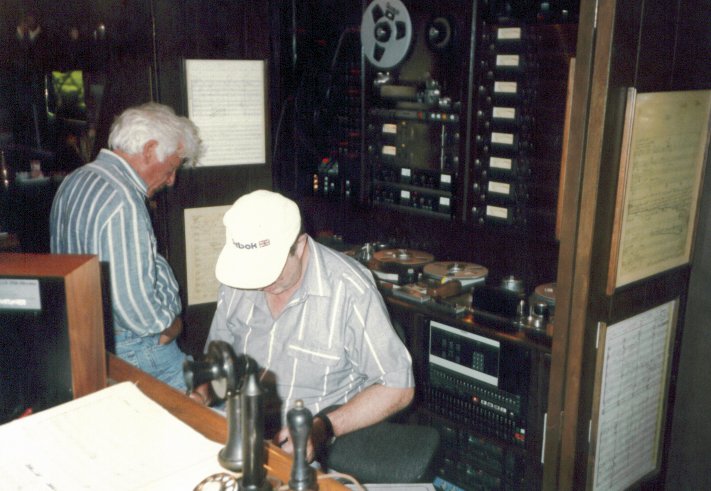
Night Crossing Mastering Sessions July and
August 1987
I was sitting at the bar of Len Engel's home in Bel
Air with Doug Fake of Intrada Records, Tapes and CD's. I was acting as
co-producer of the Night Crossing project as Doug Fake had expended quite a bit
of cold hard cash in producing their first two projects; namely Red Dawn
by Basil Poledouris and Poltergeist II by Jerry Goldsmith. I became
involved after visiting Doug's soundtrack shop in San Francisco. They
specialized in soundtracks and co-occupied a space with a movie poster salesman.
I was in the banking industry and floated the idea of releasing Night
Crossing while browsing the LP's. Once Doug learned I would be willing to
venture capital and, with the fact that he liked me, we struck a quick deal. He
made the calls,
I wrote a check and we ended up waiting for the 4th member of the party, the man
himself, Jerry Goldsmith.
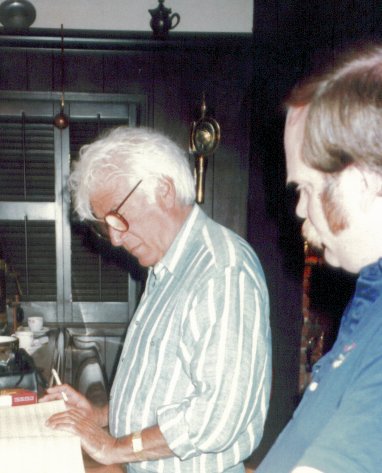
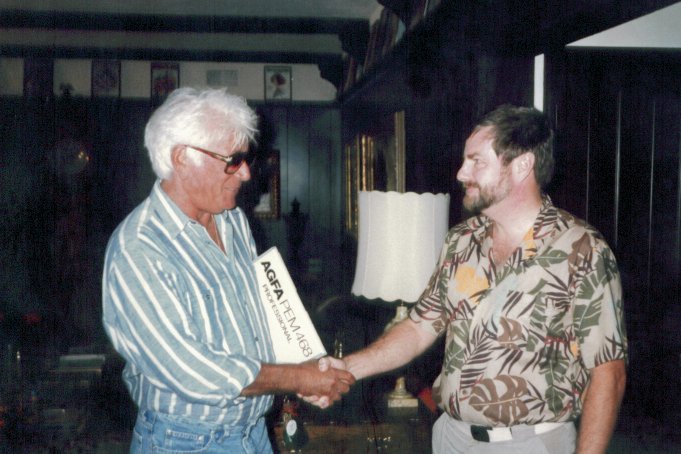
Jerry came in wearing a blue and white
striped shirt and blue jeans. I almost passed out shaking hands with him the
first time, somewhat speechless. Doug had met Jerry before but the
Poltergeist II sessions excluded his participation and his meeting was
apparently brief and formal. This time around things were quite different. Jerry
brought his copies of sheet music of Night Crossing and
spread them on the bar while mixing was underway. As I recall the 1 to 1 copy we were
working with had orchestra sessions that were overly pronounced. The trumpets
were overbearing but Len's mastery brought them into submission for the stereo
mix down.
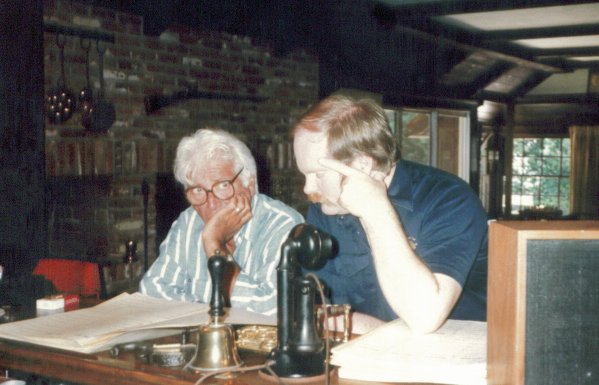
Early on an almost heated argument occurred when
Jerry thought the main title should be excluded from the album as the music in a
different form would be heard later on anyway. Doug almost had to plead for its
inclusion. Jerry let him have his way (which was correct speaking from a fan's
point of view) and peace returned to the atmosphere. A couple of great weekend
days went by listening to the tapes and watching Len make his corrections and
cuts. Jerry and Doug spent a lot of time studying the sheet music while I took a
few pix. Jerry was a tennis player and a big tennis tournament was on TV.
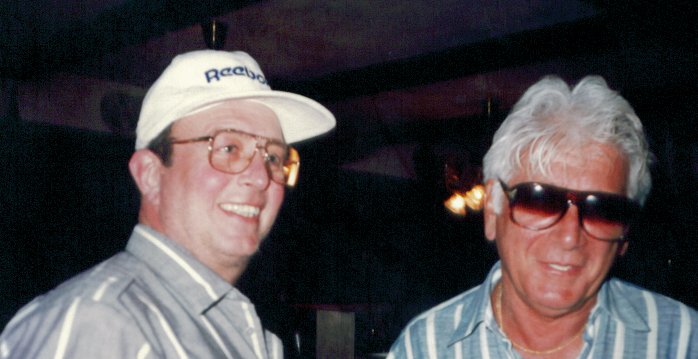
Jerry
often would sit in front of the TV enjoying the matches while Len labored. In
1987 Jerry was purported to be receiving $250,000 per score. While watching a
big match that came to a close and the trophy was awarded the player on top also
received the victor's check which came to $250,000 for a couple of days work.
Jerry laughed at this commenting that it took him six weeks to make money like
that! He also found it amusing that I told him I had been working since I was 16
(I was then 41) and probably hadn't made $250,000 yet. I have been known to have
a quick wit and a strange sense of humor but I don't think I was far off the
mark. (Follow the
link to the archives of my movie reviews for the
Santa Clara Weekly and you might understand what I am talking about.) In
the above pix I took of Jerry and Len you can see their reaction to one
of my quirky remarks. Jerry had an especially good sense of humor. On the Sunday
afternoon we finished the project Jerry left for home and Doug and I stayed
while Len made us each a cassette copy of the Night Crossing score yet to
be released. We dropped one off at Jerry's home in Beverly Hills and went out
for a movie. It was great driving around listening to that score in my car
knowing that I was the only one in the world currently capable of the act.
Night Crossing and Rent-a-Cop
Rent-a-Cop was a movie released in 1987 with Burt Reynolds and Liza
Minnelli. Along for the ride were Dionne Warwick and Robby Benson. Jerry London,
long time neighbor of the Petri's on The Dick VanDyke Show, directed. This was a
cop thriller that at the time was supposed to be Liza's "comeback" film. It was
a stinker. Only one good thing came out of the film. Jerry's score. His trumpet
led theme was lush and gorgeous. While working on the pending Night Crossing
album release, Intrada also decided to take on a newer project (Night
Crossing the movie came out in 1981) so Doug saw Rent-a-Cop as a current project
while Night Crossing was for devoted fans of Jerry who long wanted the
Night Crossing music available. We made a second trip to LA to finish up the
Night Crossing left overs like album cover and liner notes. Rent-A-Cop
allowed us to get together a 2nd time at the Len Engel residence and work on
mastering the new album.
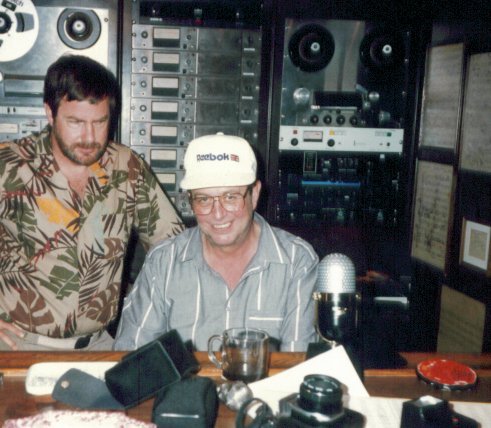
During this time we had a little controversy as
the Night Crossing album was going to run slightly longer than Union arrangements would allow without writing out another check to them.
Sidney Sax was the Manager of the National Philharmonic and their leader. Jerry
heard our plea for help.....mainly that we didn't have any more money to give to
the Union in England for a couple of more minutes of music. He borrowed Len's
phone and made a call to Sidney. Unable to reach Sidney, Jerry made it clear
that no more money was on the way and that we were including all the music we
wanted anyway. Whoever did talk to Jerry on the phone got the message when
Jerry, being belligerent with a touch of humor, said "If they think they are
getting any more money for this you can go tell Sidney he can go CENSORED
himself". No more money was sent. We included the music on the album. Len Engel
also used a noise reduction system to reduce tape hiss that wasn't in line with
the common Dolby B or A or whatever encoding the pro's used at the time. This
sent me running around Hollywood picking up equipment so the album could be
completed.
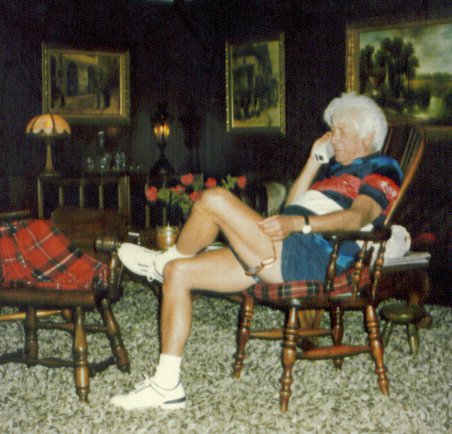
In the above and below picture you see Jerry in shorts and a red/blue/white striped
shirt that was from our 2nd time down when the Rent a Cop project was in
the works. At that time wireless phones were fairly new to home use and Len had
just bought a new one that Jerry was very impressed with. Often he would borrow
the phone to call pals and chat. He was big on Thai food at the time and I
recall that he was chatting about a Thai restaurant when I took the candid shot.
Len also disclosed that for some reason Jerry was having problems sleeping at
the time. He looked a little tired.
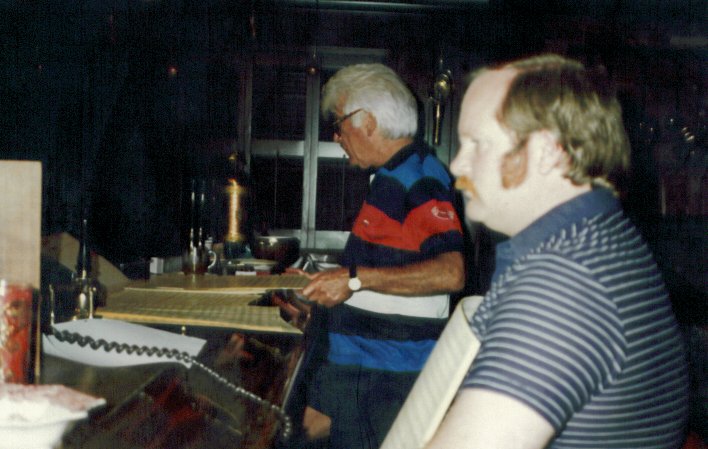
Jerry had already conducted well over a hundred scores and performed before
National and International audiences with large orchestras. Len told us that
Jerry was disappointed with his conducting abilities and was taking classes to
improve them. Go figure. While working on
Rent-a-Cop we got word that John Huston
(8/28/1987) died. This was very upsetting to Jerry because of the potential harm
the news would do to his close friend and mentor Alex North. Alex was 76 at the
time and would live another 4 years. The death of Huston brought North's wife to
Len's home in hopes of getting Jerry to help break the news to her husband.
Jerry was 58 at this time and indicated that because of the large number of
people he knew in Hollywood he spent a lot of time going to funerals. Next up
Jerry's home and studio. Pictures that as far as I know only about 6 people have
ever seen. Up to now.
At Jerry's place
.jpg)
Jerry lived at a beautiful home in Beverly Hills
not far from Len Engel's home in Bel Air. Doug and I figured out a way to visit
Jerry's home and studio since Jerry had no reason to invite us on his own. We
invited his secretary to lunch! I parked my VW van on
Jerry's drive way. We didn't get to park there long though as Jerry's wife Carol showed
up and asked us to move the van so she could park. I told her not until I take a
picture, I told her very politely. When we rang the doorbell Jerry's Secretary,
Elaine Dabick, allowed us to enter then took us through the home to Jerry's
studio in back. In a room off the front entry, Jerry had a grand piano and a
small version of it where his youngest son was being taught to play.
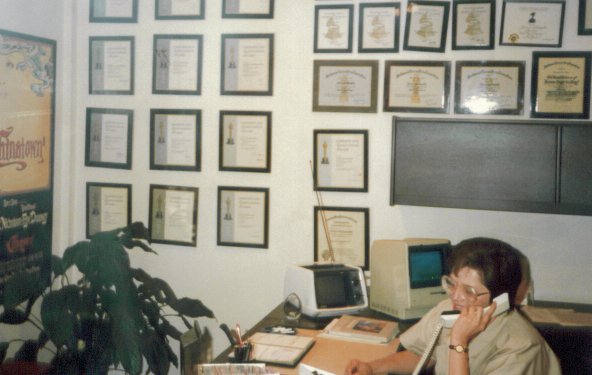
The office picture above shows Elaine on the phone
and all of Jerry's Oscars, Emmys and other award nominations on the wall. It took three shots to get them all in. Posters of his films fill out
the decor as well as a couple of concerts he had conducted. He had a poster from
Patton which he pointed out with pride had been autographed by Director
Franklin Schafner. Years later I would obtain a copy of the Patton LP
autographed by George C. Scott that I would have happily given to Jerry had I
owned it then.
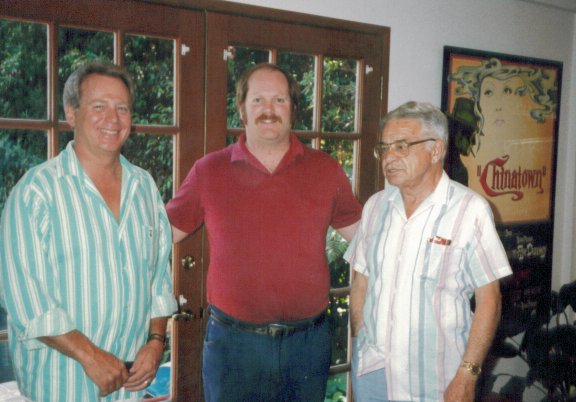
While waiting for Elaine to be free for lunch Arthur Morton (Jerry's long time
orchestrator and collaborator) and Ken Hall (Jerry's long time music editor)
showed up for lunch with Jerry. I took a picture of them with Doug. As we waited
we found that Jerry was upstairs in his studio doing a photo shoot for a
keyboard manufacturer promotion. Not being shy I decided to go upstairs and see
what I could see. The pictures show Jerry and the guy doing the photography.
The lights were hot and bright. Jerry was sweating out the session and not happy
with the outfit he had on. The pictures I took were done without his knowledge.
After I went downstairs he soon followed then went into his house and came back
in a red sweater. He apparently liked this sweater as he wore it in numerous
publicity appearances. See Gallery 2 for a picture of Jerry in this
sweater on a poster which has been autographed. As it turns out I had the exact
same sweater with me on the trip.
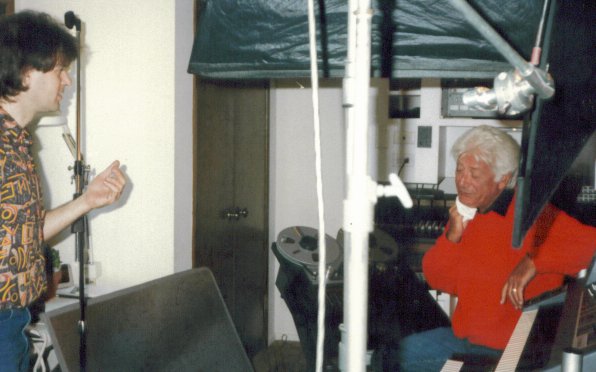
The next day when we were back at Len Engel's I wore the sweater. Jerry looked
at it and then at me and with a big smile on his face, he made no comment. We
took Elaine to a Hollywood hot spot called Ed Debevic's. It had been a long time
waiting to have lunch and Doug was
admittedly very hungry. Elaine had a bemused look on
her face seeing Doug with two (count em' two) large sandwiches he had ordered.
He definitely did not want me taking a picture of him with all this food but
well....nothing had stopped me so far. During our first trip Doug and I took
Arthur Morton out to a long lunch and had him ready and eager to talk about his
years in the film music business. With his permission Doug taped the interview
and conversation but to my knowledge has never made the tape public. Arthur was
very impressed when I was familiar with his original theme for the little known
TV show Apple's Way as most of his career was spent as an orchestrator not a
composer.
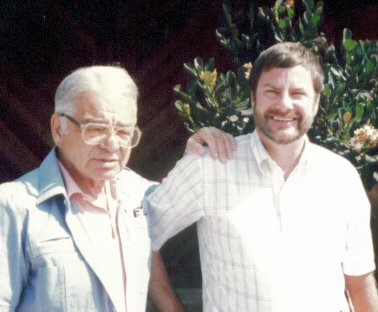
Jerry enjoyed talking about his work although, as
I have pointed out elsewhere, he tended to talk about music he composed in the
3rd person. I was always amazed that he could produce the greatest music of the
20th century and look back on it as if he were not sure where the inspiration
came from, almost as if it was done by another individual. While working with
him at Len Engel's home and after the "day's work" was done Jerry would stay
beyond the working session to chat and enjoy the company. One late afternoon he
talked about the Suites and Themes album he had recorded in March of 1987
which would be his first non- score album. It is the famous one with the
wonderful Robert Peak painting of Jerry on the cover. He was very proud and
happy with this album. He had Len play selections from his reel to reel copy. If
you own it you know what a great album this is. I asked him who did the
arrangements which were gorgeous and he almost popped a button with pride when
he claimed personal credit. He was truly an honest and unassuming individual
whose persona belied the extraordinary talent that lay just under the surface.
His body of work proves me right on one count and I am fortunate enough to be
able to attest to the other claim based on rare and unusual personal
experiences.
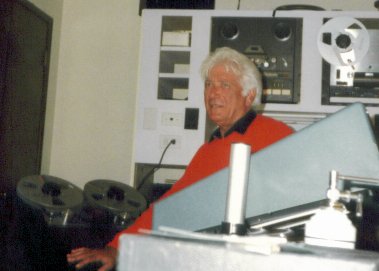
The Next Time I Saw Jerry
In April 97 Jerry came to San Jose for a concert. We joined him back stage after
the concert. I have a very rare album which is from the World Premiere of In
Like Flint. The album is Orange with the Fox In Like Flint Logo. It says Special
Souvenir Album. World Premiere. San Juan, Puerto Rico. March 4, 1967. Inside the
jacket is a mono copy of the same album that was released for sale in the
regular album jacket. I asked Jerry if he had attended this event but he said
that he was not invited. Wow. Unbelievable. This copy is the only one he had
ever seen. I assume it is the only one in the World with his autograph on it.
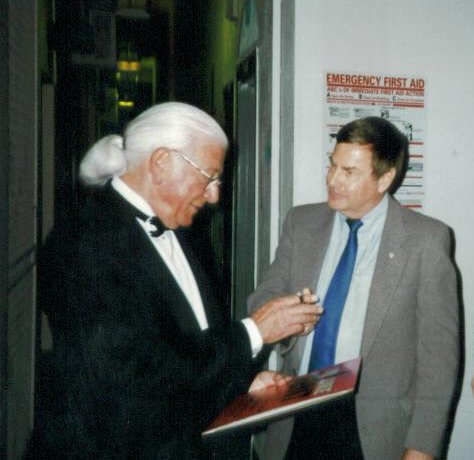
Very special thanks to Karl
for his candid look back and his fantastic photo collection on such an important
moment for Jerry Goldsmith's many fans.
Karl Scott writes movie reviews for the
Santa Clara Weekly |